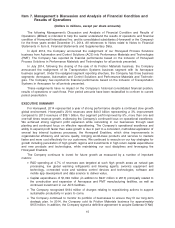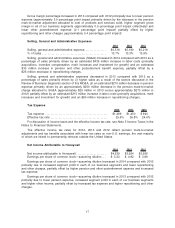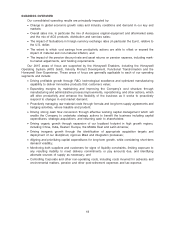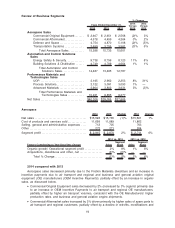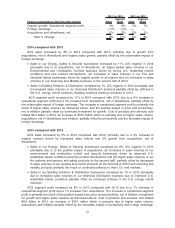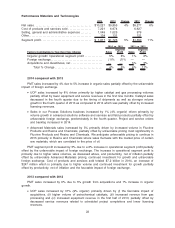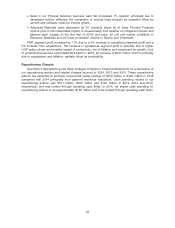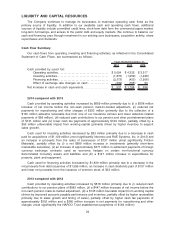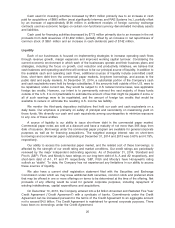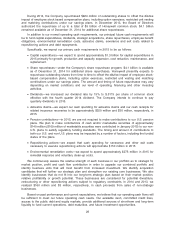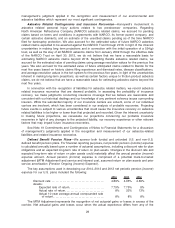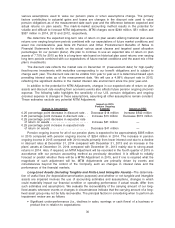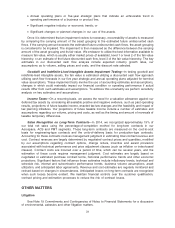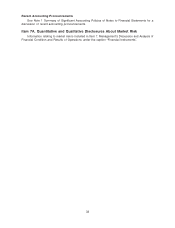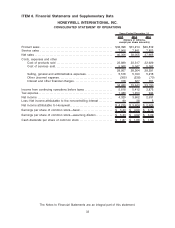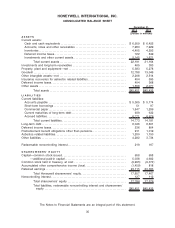Honeywell 2014 Annual Report Download - page 34
Download and view the complete annual report
Please find page 34 of the 2014 Honeywell annual report below. You can navigate through the pages in the report by either clicking on the pages listed below, or by using the keyword search tool below to find specific information within the annual report.Cash used for investing activities increased by $531 million primarily due to an increase in cash
paid for acquisitions of $695 million (most significantly Intermec and RAE Systems Inc.), partially offset
by an increase of approximately $190 million in settlement receipts of foreign currency exchange
contracts used as economic hedges on certain non-functional currency denominated monetary assets
and liabilities.
Cash used for financing activities decreased by $773 million primarily due to an increase in the net
proceeds from debt issuances of $1,462 million, partially offset by an increase in net repurchases of
common stock of $651 million and an increase in cash dividends paid of $142 million.
Liquidity
Each of our businesses is focused on implementing strategies to increase operating cash flows
through revenue growth, margin expansion and improved working capital turnover. Considering the
current economic environment in which each of the businesses operate and their business plans and
strategies, including the focus on growth, cost reduction and productivity initiatives, we believe that
cash balances and operating cash flow will continue to be our principal source of liquidity. In addition to
the available cash and operating cash flows, additional sources of liquidity include committed credit
lines, short-term debt from the commercial paper markets, long-term borrowings, and access to the
public debt and equity markets. At December 31, 2014, a substantial portion of the Company’s cash
and cash equivalents were held by foreign subsidiaries. If the amounts held outside of the U.S. were to
be repatriated, under current law, they would be subject to U.S. federal income taxes, less applicable
foreign tax credits. However, our intent is to permanently reinvest the vast majority of these funds
outside of the U.S. It is not practicable to estimate the amount of tax that might be payable if some or
all of such earnings were to be repatriated, and the amount of foreign tax credits that would be
available to reduce or eliminate the resulting U.S. income tax liability.
We monitor the third-party depository institutions that hold our cash and cash equivalents on a
daily basis. Our emphasis is primarily on safety of principal and secondarily on maximizing yield on
those funds. We diversify our cash and cash equivalents among counterparties to minimize exposure
to any one of these entities.
A source of liquidity is our ability to issue short-term debt in the commercial paper market.
Commercial paper notes are sold at a discount and have a maturity of not more than 365 days from
date of issuance. Borrowings under the commercial paper program are available for general corporate
purposes as well as for financing acquisitions. The weighted average interest rate on short-term
borrowings and commercial paper outstanding at December 31, 2014 and 2013 was 0.60% and 0.79%,
respectively.
Our ability to access the commercial paper market, and the related cost of these borrowings, is
affected by the strength of our credit rating and market conditions. Our credit ratings are periodically
reviewed by the major independent debt-rating agencies. As of December 31, 2014, Standard and
Poor’s (S&P), Fitch, and Moody’s have ratings on our long-term debt of A, A and A2 respectively, and
short-term debt of A-1, F1 and P1 respectively. S&P, Fitch and Moody’s have Honeywell’s rating
outlook as “stable”. To date, the Company has not experienced any limitations in our ability to access
these sources of liquidity.
We also have a current shelf registration statement filed with the Securities and Exchange
Commission under which we may issue additional debt securities, common stock and preferred stock
that may be offered in one or more offerings on terms to be determined at the time of the offering. Net
proceeds of any offering would be used for general corporate purposes, including repayment of
existing indebtedness, capital expenditures and acquisitions.
On December 10, 2013, the Company entered into a $4 billion Amended and Restated Five Year
Credit Agreement (“Credit Agreement”) with a syndicate of banks. Commitments under the Credit
Agreement can be increased pursuant to the terms of the Credit Agreement to an aggregate amount
not to exceed $4.5 billion. The Credit Agreement is maintained for general corporate purposes. There
have been no borrowings under the Credit Agreement.
25


